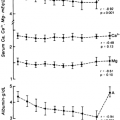EFFECTS OF CATECHOLAMINES
CIRCULATION
Cardiovascular function, both at rest and during stress, unquestionably depends on sympathetic neural activity. Interference with sympathetic outflow or inhibition of NE release from sympathetic nerve endings causes the blood pressure to decrease even in resting, healthy adults, and β-adrenergic receptor blockade causes a decrease in heart rate at rest, as well as attenuated heart rate responses to stress.
Circulatory responses during orthostasis, altered regional and total body metabolic demands imposed by exercise, changes in environmental temperature, hemorrhage, hypoglycemia, hypoxia, and emotion occur predominantly by patterned sympathoneural and adrenomedullary activation. Sympathetic stimulation causes tachycardia, increased cardiac inotropism, increasingly rapid cardiac conduction, acceleration of myocyte spontaneous depolarization, increased resistance to blood flow in most vascular beds, and venousconstriction. Because of relatively scanty sympathetic innervation of the coronary and cerebral vessels, diffuse sympathetic stimulation generally preserves blood flow to these vital organs. Total peripheral resistance may remain unchanged or may decrease, depending on the extent of EPI-induced skeletal muscle vasodilation.
More indirect or longer-term effects of sympathoadrenal activation on circulatory function include (a) antidiuresis and stimulation of renal sodium retention by direct tubular effects, as well as by enhanced reninangiotensin-aldosterone system activity, reduced intrarenal hydrostatic pressure, and increased vasopressin secretion, possibly shunting corticomedullary blood flow37,38,39,40,41,42,43,44,45 and 46; (b) stimulation of cell growth and division in cardiac and vascular smooth muscle tissue42,43; (c) α2-adrenergic receptor–mediated promotion of platelet aggregation; (d) shunting of blood toward the cardiopulmonary region, which causes stimulation of low-pressure cardiac baroreceptors; and (e) adrenoceptor down-regulation.
Stay updated, free articles. Join our Telegram channel

Full access? Get Clinical Tree






